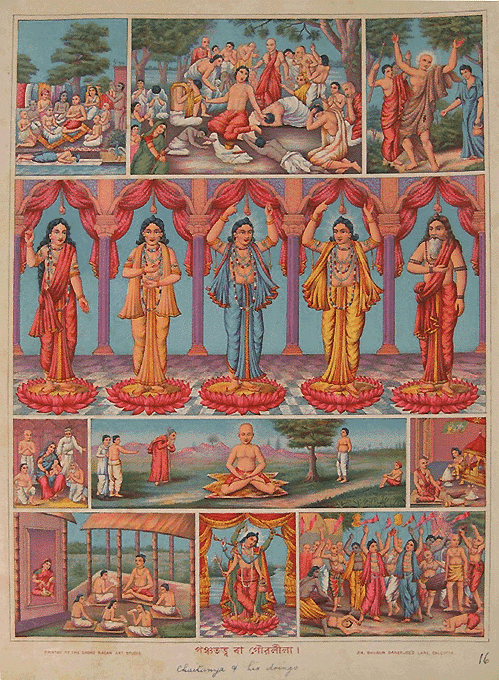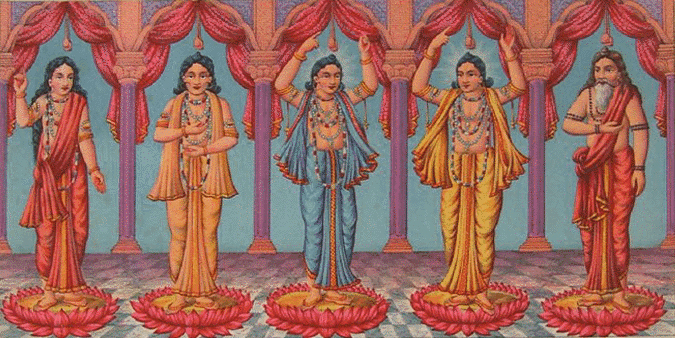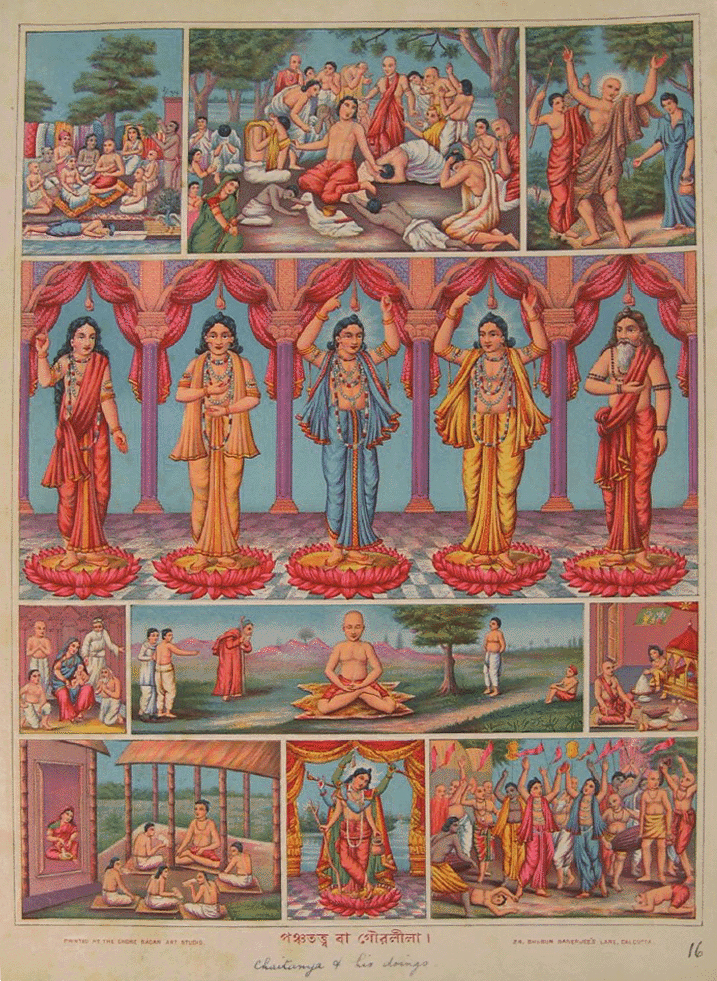
|
|
|
|
BY: SUN STAFF

Chaitanya and His Doings Mar 30, 2011 — CANADA (SUN) — A study of the historical, spiritual and cultural elements of Vedic design. Today we resume our presentation of the super-excellent devotional images produced by the Chore Bagan Art Studio of Calcutta, who in the late 1800's published many chromolithographs featuring Vaisnava themes. Of all the art presses operating in India at that time, Chore Bagan appears to have produced the greatest number of prints featuring Lord Caitanya Mahaprabhu and His associates, along with the more widely available images of Radha-Krsna, Krsna-Balarama and other transcendental personalities. During the 1880's and 1890's, Chore Bagan's studio on Bhoobun Bannerjee Lane in Calcutta was well known among Bengali citizens, many of whom purchased images of the popular Kali and Chinnamasta. Along with the Gaura and Krsna-lila prints, there were numerous lithographs produced by the press featuring Dasavatar, Rama and Ravana, and other scenes from the epic Ramayana and Mahabharata. While the majority of Chore Bagan prints were produced at their Calcutta studio, the final four prints in the studio's published folio were actually published around 1910 by the Ravi Varma Press in Lonavla, Pune. While the four prints produced for Chore Bagan by Ravi Varma press maintained Chore Bagan's own philosophy and artistic style, the publishing operation of Ravi Varma and his brother, founded in Bombay and later moved to Lonavla, was responsible for significant changes in the design motif of devotional prints which followed the Chore Bagan era. Under Raja Ravi Varma's hand, deities like Sri Krsna, Lord Rama, Laksmi and Saraswati began manifesting a new pan-India look in their costume, paraphernalia and setting. These new hybrid images quickly became popular, fueled by the increasing influence of western art. We will talk more in future segments about how these western academic conventions reshaped India's traditional devotional art styles, taking what had once been imagery imbued with a transcendental mood, and brining it down to the human level of "realism". Of course, the devotees understand this trend to be more akin to atheism than actual realism, as man remakes God into his own image in an effort to be God, rather than serve Him.

Sri Panchatattva Today we are pleased to share another of the beautiful Chaitanya-lila lithographs from Chore Bagan, this one entitled "Chaitanya & his doings". This is plate number 16 from the folio we previously described, in which a large collection of the press's Vaisnava prints were mounted on cloth pages. "Chaitanya & his doings" is quite an unparalleled piece, being a unique collection of many individual scenes. These vignettes of Gaura-lila are similar to, but not exactly the same as other Chore Bagan panels depicting the same lila pastimes. To our knowledge, this is not a standard collection of lila scenes that other presses also published, but is instead Chore Bagan's own hallmark piece. While the individual images will all be familiar to the devotees, each one of them has singular design elements that represent Chore Bagan alone. The overall layout, however, is one commonly found in India devotional artworks, i.e., many small panels that frame a larger central image. This design motif is commonly used in representations of Dasavatar, Krsna-lila, Lord Jagannath at Puri Dhama, and other Visnu scenes. In this case, the central image is a brilliantly colored print of the Panchatattva. Lord Chaitanya and His divine associates stand in a row on lotus pedestals. It's interesting to note that in this rendition of Panchatattva, Nityananda Prabhu is in the center position, with Lord Chaitanya on His left side (our right). There are no indications in the print, and no explanations published that we can find to explain this placement. In a previous segment, we looked at a double-panel print with Sri Sri Gaura-Nitai on one side and Lord Chaitanya on the other, and it was very clear that Chaitanya was depicted as the most prominent of the two. Perhaps the art studio was influenced by a strong presence of Bengal's Nityananda branch followers. But it seems more likely that the placement of Nityananda in the center was simply an artistic choice: Nityananda's bright blue garment at center brings more symmetry to the panel than if He and Mahaprabhu were reversed. But we can only speculate. Regardless of this rather un-philosophical design motif, the Panchatattva image is indeed beautiful. Here we have a very good example of Chore Bagan's pioneering use of chromolithography, which allowed them to produce such brilliance of color. It's interesting to note that in the majority of panels (six), Lord Chaitanya is depicted in a red dhoti, while in one he wears brown, and in the Panchatattva panel, golden yellow. The red is most likely meant to represent the saffron of sannyasa, which may have been a nuanced shade difficult to achieve using lithographic techniques of the day. All six images in the top and bottom rows are quite familiar scenes, and with the exception of Mahaprabhu teaching gurukula (albeit in saffron/red, not white), all these images have been reproduced many times by other artists. The row of images directly beneath the Panchatattva are less commonly seen, particularly the prominent center image. It depicts Lord Chaitanya seated on a deer or tiger skin, in meditation, while various devotees and others stand by. The identity of these onlookers is not made obvious. In this yoga pose, Lord Chaitanya looks rather like Buddha. The small image on the left pictures baby Nimai in the lap of Mother Saci, with His father, Advaita and devotees surrounding. The far right image we assume is a depiction of Nimai stealing the brahman's bhog offering for his deities. Both the sada-bhuja and sankirtana scenes at the bottom are familiar, and both have been published in similar renditions by other presses. We'll comment further on the sankirtana panel in a later segment, when we explore a full-size version of this image in a more refined print by Chore Bagan. All in all, this wonderful lithograph of the Lord's lila pastimes is a rare beauty, and represents a mixture of both traditional and untraditional depictions of these scenes. Overall, the style is markedly Bengali, and the design motifs clearly Vaisnava. Nityananda's presence at the center of the Panchtattva is the only point of departure from a panel that is otherwise consistent with our own Gaudiya Vaisnava mood.

| |